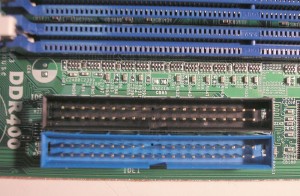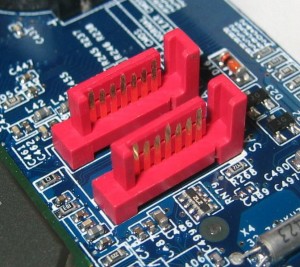by David Hakala
One day you may decide you need a bigger hard drive; a second hard drive so you can keep your data separate from your operating system; or a replacement for a drive that died. Then you will need to perform the following minor surgery on your computer.
First, buy the right kind of new hard drive. The connector between the drive and your computer’s motherboard is the key. The IDE (or ATA) standard has been around for ages and your computer probably supports IDE/ATA if it’s more than two years old. IDE/ATA uses a flat ribbon cable about two inches wide, with an 80-pin connector. Newer computers use the SATA standard, which features a thin round cable with only 8 pins in the connector. If you can use either, go with SATA. Its thinner cable is easier to install and SATA moves data faster.
Open your computer’s case; a Phillips head screwdriver should be all you need.
If you are replacing a drive, unfasten the screws holding it in the drive bay. Slide the old drive out of its bay. Unplug the power supply cable and the cable connecting the drive to the motherboard.
If necessary, configure the new drive as either a master or slave drive. A master drive plugs into the connector on the end of an IDE/ATA cable. A slave drive plugs into the connector in the middle of an IDE/ATA cable. The documentation that comes with the new drive will show you how to set the little rubber jumpers on the drive’s rear end to make it a master or slave.
Plug the motherboard connector and the power cable into the new drive. Slide the drive into its bay and screw it in place securely.
Laptops are easier than desktop computers. Generally speaking, you will unscrew just one screw to open a small door in your laptop’s case. You will pull a plastic tab to unplug the hard drive and slide it out. Push the new drive firmly into its bay, replace the door, and you’re done.
Now you have to format the new drive to make it ready for data, and possibly partition it into two or more logical drives. Formatting a hard drive is covered in the Tiplet article How to Format or Reformat a Hard Drive.
David Hakala has perpetrated technology tutorials since 1988 in addition to committing tech journalism, documentation, Web sites, marketing collateral, and profitable prose in general. His complete rap sheet can be seen at http://www.linkedin.com/in/dhakala


